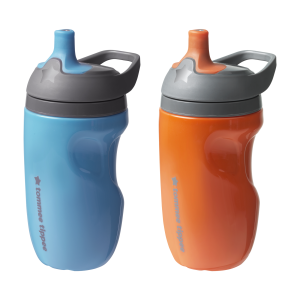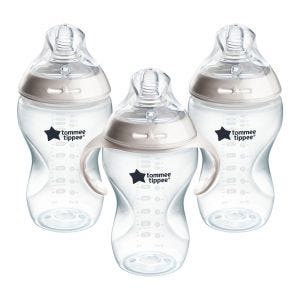
Tommee Tipps
When it comes to exercising during pregnancy, remember to listen to your body and recognise what you’re capable of. It might be a lot more than you think!
Exercising During Pregnancy: Guidelines and Tips
Exercising when you’re pregnant is a great way to stay motivated, fight fatigue and even cope with labour. It isn’t dangerous for your baby and if you want to exercise while pregnant, there’s no reason why you shouldn’t – unless you’re told otherwise by a doctor.
If you're used to a certain kind of workout in your daily life and you'd be sad to miss out during your pregnancy – absolutely continue if you feel up to it. The most important thing to do is listen to your body and recognise what you’re capable of while you’re pregnant. It might be a lot more than you think!
Let’s run through the benefits of exercise during pregnancy, how you can stay safe while exercising and highlight some of the best pregnancy exercises.
The benefits of exercise during pregnancy
Not only is exercise perfectly safe for you to do if you have an uncomplicated pregnancy, but it can also have some major benefits that go beyond fitness. If you didn’t have an exercise regime before pregnancy, these benefits might be the perfect nudge to pick one up:
- Reduces high blood pressure: If your blood pressure is on the high side, regular exercise and staying hydrated can help to get it down.
- Improves your mood: Sometimes, if you’re stressed or anxious, the last thing you want to do is work out. But exercise releases lots of glorious endorphins that can help you deal with stress and lighten the load a little.
- Helps you sleep better: Kind of an obvious one… exercise is tiring. If you’re struggling to sleep, go for a nice brisk walk or try some Pilates. Anything for a good night’s sleep.
- Eases backache: Growing another human puts some pressure on your body, a bunch of which is focused on your back. Exercise is a great way to relieve some of the tension in your lower back especially.
It doesn't have to be strenuous if that's not what you're into! Walking or swimming are great ways to get a low-maintenance workout in and bask in the many benefits of staying active while pregnant. If you're an avid weightlifter, pump that iron – whatever you feel comfortable with!
The best exercises for pregnancy
Safe exercises are ones that you feel happy, secure, and comfortable with. Whether you started as a couch potato or you're a total fitness fanatic, there are plenty of workouts that are safe and suitable, specifically for you. Here are some tried and tested examples of safe pregnancy exercises and workouts that we're sure you'll love:
Prenatal yoga
Yoga is good for the mind, as well as the body! It eases tension, clears your head, and lets you focus on yourself for a little while. It's also great for practising those breathing techniques that'll come in handy during the birth of your little one.
Water aerobics or swimming
Pool-based exercises are great if you’re looking to take it easy. You feel lighter than air and there’s no pressure on your joints and ligaments.
Pregnancy Pilates
Or just regular Pilates, while pregnant. This one is a great, low-impact workout to improve flexibility, stretch out those kinks and aches and strengthen your pelvic floor!
Running
If you were a keen runner before you became pregnant, it’s usually safe for you to continue jogging for as long as you feel able to.
Walking
Walking is a great exercise as it's free and can be done throughout your pregnancy if you feel comfortable. Getting out into the fresh air is great for both your mind and body!
Pregnancy ball exercises
Top tip, invest in a pregnancy ball! Not only will this superb invention encourage you to sit up instead of slump on the sofa, but it also comes with a host of exercises that are great for relieving back pain and tension, as well as distributing weight more evenly and taking some of the pressure off.
Start by gently rocking back and forth, rotating your hips, alternating the direction, and moving in a figure of eight. This is good to do while watching TV or reading.
If you’re looking to challenge yourself a little, you can try some tougher exercises with your ball – such as wall squats. Stand up and place the ball between your back and the wall, then simply slide down the wall into a squat position. The ball will support your back, and squats in general are a great way to build strength and endurance.
Pelvic floor exercise in pregnancy
While pregnant, your pelvic floor muscles will relax due to hormonal changes in your body. This could cause you to pee a little when you sneeze, laugh or exercise – totally normal, but there’re some things you can do to avoid this. Doing pelvic floor exercises (Kegel exercises) can stop those accidental leaks as well as strengthen your stomach and ease backache.
Try clenching your bum like you’re trying to hold in a poo and bring your pelvic muscles (vagina) up towards your belly. Hold this for around 10 seconds, if you can, and then release. Do this around 10 times and try to repeat the exercise three times a day. You’ll probably find that you can hold for longer each time you do it. This one is also great if you’re working at a desk while pregnant – multitasking at its finest.
Back exercise for pregnancy
Back pain is one of the more annoying attributes of pregnancy, but something that most pregnant people experience at some point. It’s normally caused by carrying extra weight (a small human) and shifting the centre of gravity in your body.
Gentle stretches and low-impact exercises can often ease back pain and even strengthen your back, shoulder, and arm muscles. Simple arm and leg raises are perfect for straightening your back and easily stretching those muscles. Kneel on your hands and knees, with your back as straight as you can get it, then lift your right arm and left leg, hold that position for as long as you’re comfortable and switch.
Should I do pregnancy exercises at home or as part of a class?
Some women love going to classes specifically for pregnant women – mingling with the other mums-to-be and sharing the journey while getting a healthy workout. Others prefer to stay home and exercise on their own.
It’s a personal choice and completely depends on what you’re comfortable with!
If you think exercise classes sound like a hoot, there’re a bunch of terrific ones that are wonderful for keeping you fit and active while pregnant. These are available at pretty much any gym or community group.
If you’re more of a homebody or you're short on time, you can still enjoy pregnancy exercise classes or professional routines (not water aerobics, obviously). There are so many wonderful YouTube tutorials that you can follow for your daily dose of physical activity – even half an hour a day of beginner's yoga gets your muscles stretched and your heart going!
Pregnancy exercise safety
Whatever exercise you do during your pregnancy, you should always stay safe and take care of yourself. Be sure to keep the following pointers in mind throughout your pregnancy:
- Avoid exercising in extreme heat.
- Stay hydrated by drinking plenty of water before, during and after your exercise.
- Eat a healthy snack before and after your exercise to keep your energy levels up.
- Get clearance from your doctor if you’re new to exercise or you have any health conditions that may be negatively impacted by exercise.
- Wear a supportive sports bra or a belly band to ease any strain on your back.
- Do what feels right for your body and don’t exercise to the point of exhaustion.
- Avoid exercising if you’re experiencing lots of Braxton Hicks contractions.
- Always warm up before and cool down after any exercise.
Which pregnancy exercises to avoid
Although exercise is great and encouraged while pregnant, there are exercises that should be avoided during pregnancy.
Firstly, if you're not used to exercising but trying to get into it while pregnant, don’t push yourself! Try and begin with 10 minutes of easy exercise a day and build from there.
As a rule, it’s best to steer clear of any exercises that require you to lay flat on your back for long periods after 16 weeks.
Here are some other workouts you'll want to avoid while pregnant.
- Hot yoga (or hot anything): It's best to not increase your body temperature if you can, for the same reason why hot tubs should be avoided while pregnant. It could cause nausea or dehydration and that's not what we want. If you're a hot yoga fan, maybe try and switch to pregnancy yoga for a while.
- Scuba diving: A rare hobby, but you never know! Scuba diving can have some serious effects on your baby, so is best to avoid it.
- Contact sports: Activities where you could be hit with force or knocked over aren’t a good idea while you’re pregnant.
If you’re unsure about certain exercises while you’re pregnant, or you find it tougher than usual, you can always pay a visit to your doctor. The most important thing to do is stay at your own pace. If you feel comfortable running a 5K, go for it! But if you’re more of a brisk walk kind of person, that’s great too.
Signs to stop exercising during pregnancy
It’s generally recommended that you stop exercising right away if you feel unwell or are in pain, and this is particularly important when you’re pregnant. You should stop exercising and talk to your doctor or midwife if you…
- are having trouble catching your breath
- feel dizzy
- have chest pain
- feel your heart is beating in an irregular way
- can feel tightening or pain around your tummy or pelvis
- have any bleeding from your vagina
- feel weak or exhausted
- have a headache
- experience pain or swelling in the lower part of your legs
- can’t feel your baby moving as much.
When can I start exercising again after pregnancy?
When it comes to getting into a postpartum exercise routine once your baby’s born, it’s important to take your time, consult your healthcare provider, and listen to your body. The time it takes to recover from pregnancy and birth varies from one person to the next, and if you’ve had a caesarean section, your recovery time may be longer.
Generally, you can start to go for walks and do pelvic floor exercises and gentle stretches as soon as you feel able and comfortable. But it’s best to wait until your six-week postnatal check-up before you return to any high-impact exercises.











